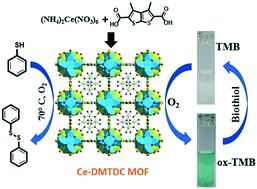A cerium-based metal–organic framework having inherent oxidase-like activity applicable for colorimetric sensing of biothiols and aerobic oxidation of thiols†
Abstract
A cerium-based metal–organic framework (MOF; 1) with a UiO-66 (UiO: University of Oslo) framework topology was synthesized solvothermally by employing 3,4-dimethylthieno[2,3-b]thiophene-2,5-dicarboxylic acid as a ligand. The MOF was thoroughly characterized by X-ray photoelectron spectroscopy (XPS), X-ray powder diffraction, infrared spectroscopy, and thermogravimetric and N2 sorption analyses. The activated material (1′) retained its structural integrity in water, acetic acid and 1 M HCl solution. XPS investigation reveals the presence of both Ce(III) and Ce(IV) ions in 1. Owing to the presence of mixed-valence cerium ions, 1′ was able to oxidize the chromogenic peroxidase substrate 3,3′,5,5′-tetramethylbenzidine (TMB) or 2,2′-azinobis(3-ethylbenzothizoline-6-sulfonic acid) (AzBTS) in the absence of an external oxidizing agent. Thus, it showed inherent oxidase-like catalytic properties. Inspired by the excellent oxidase-mimicking activity of 1′, a protocol was developed for the rapid colorimetric sensing of biothiols in NaAc buffer (0.2 M, pH = 4). The sensing ability of 1′ towards cysteine was also demonstrated in human blood plasma. Furthermore, the redox-active cerium ions enabled 1′ to exhibit excellent heterogeneous catalytic performance in aerobic oxidation catalysis of thiol compounds. The material is reusable (both as a sensor and as a catalyst), low-cost and highly stable, which renders it a promising candidate for the monitoring of biothiols in immunoassays and medical diagnosis as well as for industrial oxidation catalysis.



 Please wait while we load your content...
Please wait while we load your content...